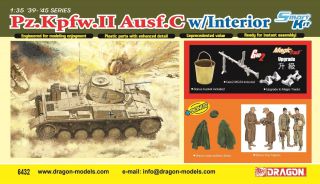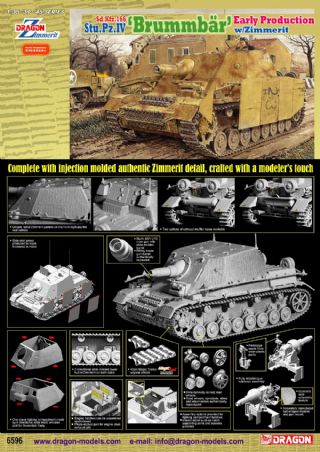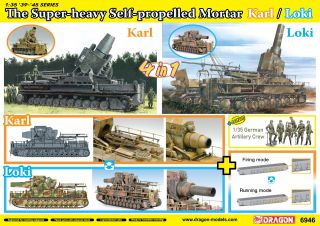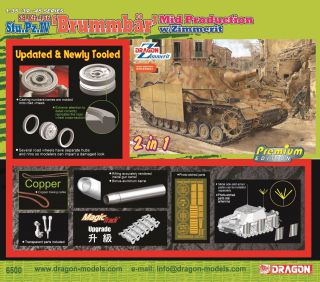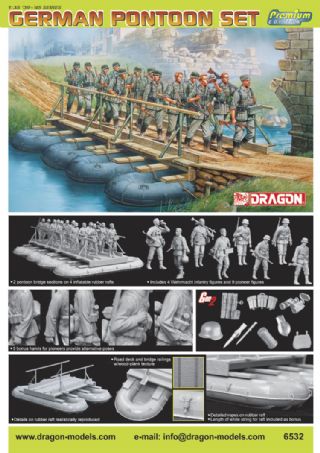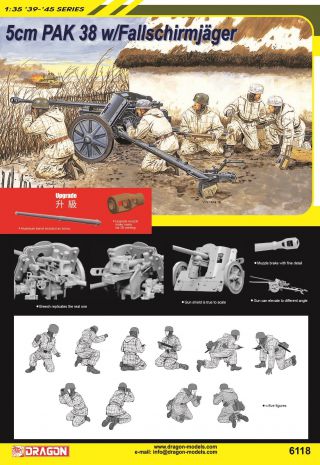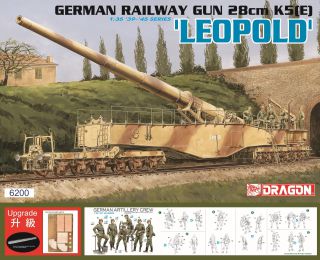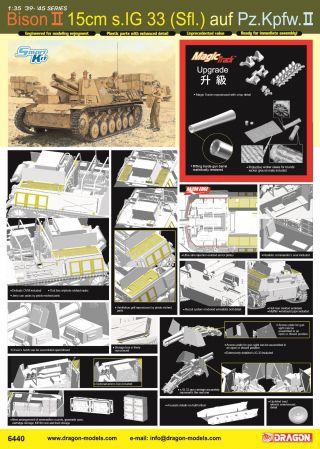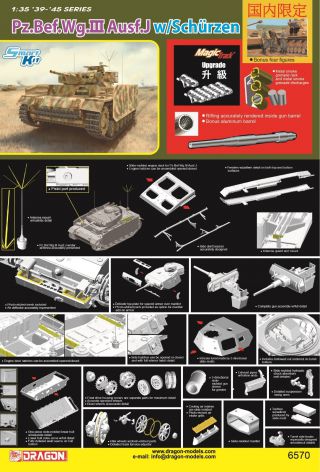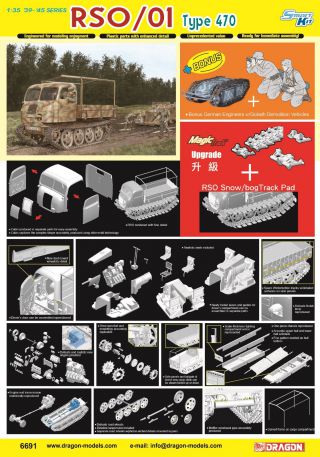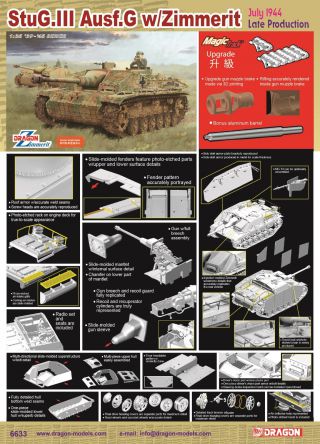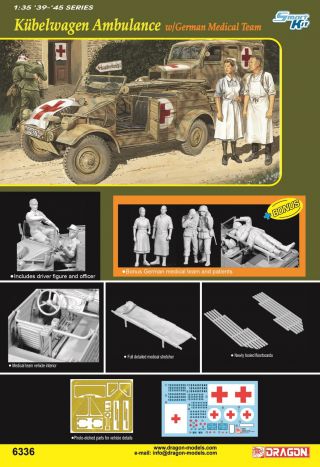HOME → Dragon Plastic Model Kits → 1/35 WWII Military → 6761


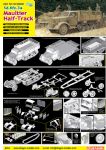







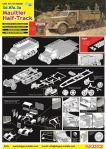
Barcode: 0 89195 86761 2
Packaging: 20 Pieces per carton
Box Size: 9.6" x 15" x 2.4"
Features:
- Newly tooled Maultier rendered w/full detail
- Fully detailed cargo bed can be assembled open/closed
- Delicately detailed cargo compartment
- Delicate side and tailgate w/great detail
- Fully detailed chassis
- Delicate engine represented
- Intricate fuel tank mounted on newly produced chassis
- Sprockets and idler wheels rendered w/accurate detail
- Realistic road wheels assembled from separate in separate parts
- Realistic engine hood covers formed from multiple parts w/louver detail
- Detailed radiator cover w/filler cap
- Accurately shaped front fenders
- Slide-molded engine hood frame
- Realistic engine hood covers can be assembled open/closed
- Detailed dashboard and driver's compartment
- Intricate driver's seat w/realistic cloth pattern
- Driver's door can be assembled open/closed
- Highly detailed Magic Tracks reproduced
- Finely detailed vehicle tools
- Includes clear lenses for headlamps and spotlights
- Delicate wheels w/authentic tire tread pattern
Modelers have been anticipating the arrival of a contemporary kit of the famous semi-tracked Maultier, whose name means “mule”. The origin dated from 1941 when German troops fighting on the Eastern Front quickly bogged down in the treacherously muddy conditions at the start and close of wintertime. Wheeled trucks couldn’t handle the tough conditions, so the decision was made to obtain half-tracked trucks that could negotiate the mud. The rear axles of standard cargo trucks were replaced with drive shafts connected to track assemblies from retired Panzer I light tanks. The 7.1-tonne Maultier, introduced from 1942 onwards, was largely successful although they weren’t quite as mobile as purpose-built halftracks. Load capacity was also reduced to 2 tons. Production of some 4,000 vehicles ceased in 1943 in favor of the RSO tractor.
This stunning 1/35 scale kit, fully living up to the standards expected by current-generation modelers, is based on 3-ton truck released earlier. However, it features a great many new parts such as wheels, suspension, tracks, chassis and cargo bed to ensure the vehicle is top notch in every respect. For the serious modeler wishing to depict a realistic Eastern Front winter scene, this Maultier will prove an invaluable asset. Whether accompanying one of Dragon’s many panzer kits in a frontline diorama, or negotiating thick mud or snow, this kit allows modelers to pursue their wildest imagination. The years of anticipation for a new Maultier are now being generously rewarded!
Reviews:
Sd.Kfz.3A Maultier Half-Track
Manufacturer: Dragon Models
Scale: 1/35
Material: Styrene & Photo-etch
Serial Number: 6761
Price: TBA
Dragon:
The famous semi-tracked Maultier, whose name means 'mule' had its origins dating from 1941 when German troops fighting on the Eastern Front quickly bogged down in the treacherously muddy conditions at the start and close of wintertime. Wheeled trucks couldn't handle the tough conditions, so the decision was made to obtain half-tracked trucks that could negotiate the mud. The rear axles of standard cargo trucks were replaced with drive shafts connected to track assemblies from retired Panzer I light tanks. The 7.1-tonne Maultier, introduced from 1942 onwards, was largely successful although they weren't quite as mobile as purpose-built halftracks. Load capacity was also reduced to 2 tons. Production of some 4,000 vehicles ceased in 1943 in favour of the RSO tractor.
Kit Contents
The kit is supplied (not surprisingly) in the standard sized Dragon box, but what is surprising are the contents. They're well packed with each sprue sealed within its own plastic bag, the Dragon black card on top with photo-etched sprue, windscreen masks, decal sheet and transparent sprue all individually bagged and taped to the card. In addition, attached to the side of the card, as usual is a small bag of 'Magic Track' individual track links. The thing that's surprising about them is that there doesn't seem to be enough. Trust me...there is. There are even quite a few parts marked as 'not for use' due to the sprues from Dragon's Opel Blitz that are included for the common parts.
Given that the Opel Blitz is itself a fairly new kit, relatively speaking, then everything inside the box is well up to modern standards in terms of sharpness of detail, plus engineering wise, there's nothing where it shouldn't be, such as ejector pin marks on surfaces you'll see on a finished model etc. If you've built the Opel kit and enjoyed it, and I've built a couple now...and enjoyed them...then you'll more than likely get even more enjoyment from building this one. It's that type of subject. A lot of modellers have been waiting a long time for somebody to do one of these, and it took Dragon to step up to the plate.
Construction begins with assembling various sub-assemblies for later installation, for example the two front wheels, the engine, front suspension etc. Each of the two front road wheels is from the original Opel kit and constructed from two halves that sandwich the three-part hub, however, they weren't used in that kit since there were alternative ones supplied on a sprue that isn't included in this kit. There are alternative ones supplied in this one too, although they're marked as 'not for use', so we can expect more versions.
There's a full engine included in the kit, and it's supplied on a new sprue, although the old one is still included and marked 'not for use'. Both are almost identical, although because of the way this kit is constructed, the new one is supplied without the sump moulded to the bottom of it, but as a separate part. Once assembled however, it's exactly the same as the other one, but with one less seam to sand. You should be careful of the instructions at this point too, since they indicate that the engine should be seated on the chassis, part C41. This is the one that should not be used. The chassis that is labelled H35 has to be used instead. Also included is a complete radiator and housing, so with the addition of some fine wire and tubing you could really detail this up and have the hood opened for display or as part of a diorama scene. The front suspension consists of axle and leafspring unit, the steering mechanism is modelled but fixed.
Once the above components are constructed, they can be fixed in place onto the one-piece chassis. This is almost identical to the Opel Blitz, and is the same dimensions, but has the baseplates from beneath the engine compartment removed and also has new locating points for the different running gear components. Speaking of which...they're all of course, brand spanking new, and therefore supplied on a brand new sprue! The suspension of these vehicles were of a Carden Lloyd type similar to that of the Universal carrier. There are two pairs on either side, with the suspension springs facing forward on the forward pair and rearwards on the rearmost pair. Of course, all of the running gear elements are new, apart from the tracks which are from the Dragon Pz.Kpfw.I series of kits. The tyres of the roadwheels can be seen in the pictures shown below to have size information embossed on their sidewalls, but no manufacturer's logo. Once constructed, each of the suspension bogey's are fixed to a tubular frame fixed around the rear of the vehicle's chassis, in exactly the same manner as the original was constructed.
Back to the bodywork, and the parts to construct the engine compartment itself, plus the front of the vehicle, are straight from the Opel Blitz kit, with even the tiny photo-etched 'Opel Blitz' badge for the radiator grill being supplied. The engine compartment is supplied as a slide-moulded 'frame' onto which the radiator grill and hood panels are fixed. The side panels are superbly moulded, with open ventilation louvres. Each of the hood panels are shown closed or opened, yet no mechanism is described or shown for retaining the two panels in the raised position? Presumably there was some sort of stay, but you'll have to do a little research into that one. Before fitting the engine bodywork assembly to the chassis, there's a sub-assembly consisting of the two fenders plus cab floor to build and fit, with a fuel tank that fits into place beneath the driver's bench seat. The rear wall of the cab is supplied as a separate part, as is the cab roof, which is moulded with the two windscreen pillars in place. Since the doors are both provided as separate parts, this method of construction actually results in the smallest possible joins that may need to be sanded down etc. The detail inside the cab is fairly comprehensive, i.e. foot pedals, gear lever, handbrake, etc., plus internal detail such as handles and window winders on the doors. The dashboard is moulded with the outlines of the dials, but smooth faces, the dials themselves being supplied on the decal sheet...by far the best way to do it. The glazing is provided as transparent injection moulded parts, with a series of masks being provided, although there are only masks for one side, so if you wish to paint the inside of the cab, you'll have to either provide your own or paint it without the glazing in place.
The rear cargo bed is constructed in a similar way to that of the Opel Blitz truck, the various parts being supplied on a new specific sprue, the differences being mainly due to the presence of the new running gear, and therefore confined to its lower surface. The actual load bed itself is still supplied as one main piece onto which the side panels are fixed, which can of course be positioned raised or lowered. There are a couple of stowage or tool boxes to fit to its lower surface and a pair of photo-etched mudflaps to fit to its front end.
There are five marking schemes illustrated on the instructions, all from the Eastern Front as you'd expect, apart from one vehicle marked '28' as a driver training vehicle from Germany. See below for full details.
Conclusion
This one has been so eagerly anticipated by so many Axis modellers for such a long time! Has it been the worth the wait? Oh yes....
The engineering and moulding is more or less state of the art, and the subject is of course perfect for a lot of people. Multiply your fun and buy three. Highly recommended.
- Vinnie Branigan


